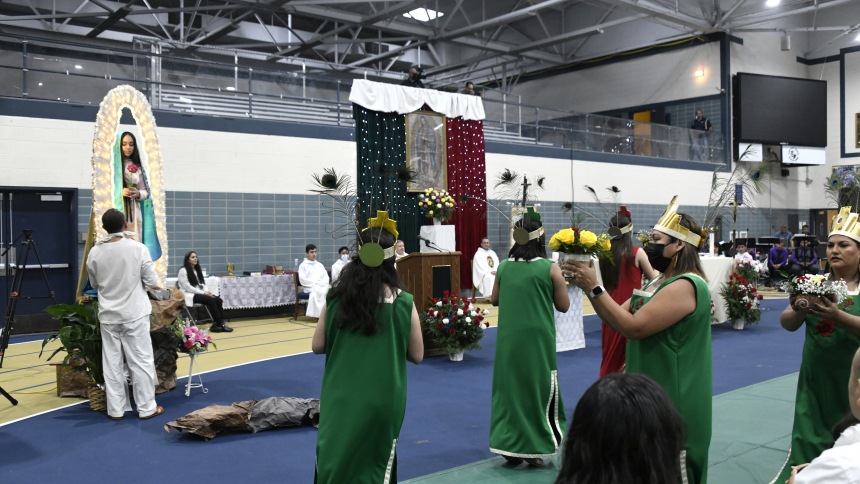
Many diocesan faithful attended Masses and participated in colorful celebrations to honor Our Lady as La Virgen de Guadalupe in the days leading up to the feast day of the Patroness of the Americas on Dec. 12.
In performances by folklorico dancers and during the fellowship of meals featuring ethnic cuisine, area Catholics showed solidarity in their devotion to the Blessed Mother, whose apparitions changed the course of Mexican history starting in 1531.
Our Lady of Guadalupe was called a “gift from God,” and someone who “accompanies Jesus,” among other terms of affection by those present at events throughout the diocese.
At Bishop Noll Institute’s fieldhouse on Dec. 11, hundreds of parishioners from St. Margaret Mary, which is adjacent to the BNI campus, joined in a Mass presided over by Bishop Robert J. McClory. Event coordinators said the venue was necessary to accommodate the large response anticipated from invitations to parishioners for the annual Our Lady of Guadalupe gathering.
Watching processions of the Guadalupana Dance troupe of St. Margaret Mary before and after Mass, Bishop McClory clapped his hands joining in the festive spirit of the performances. Dancers from children to seniors wore brightly-colored, hand-made garments authentic to various regions of Mexico.
In his homily, Bishop McClory reminded Catholics, citing the Gospel reading from St. Paul's letter to the Philippians, that “We are to rejoice in the Lord always ... that can sound very difficult because our lives can have challenges and problems.” He continued speaking about thankfulness as an antidote to anxiety. “We come here on this day, and we give thanks to the Lord for the beautiful things he's done through his mother, La Virgen De Guadalupe.”
Concluding the Mass at BNI, dancers each carried notes, photos and other symbols and placed them before the feet of the artistic representations of La Virgen de Guadalupe, hoping for her intercession.
Alicia Saavedra, director of the St. Margaret Mary Guadalupanas (dance troupe), believes her artistic service is a form of evangelization, especially to those of Hispanic heritage who have a strong connection to Our Lady of Guadalupe. But her volunteer efforts are also something deeply personal and prayerful.
“What I want to show the people is what (Our Lady of Guadalupe) brings us: it’s not her, it’s him (Jesus).” said Saavedra, who earlier gathered the Guadalupana dancers together for Eucharistic Adoration in preparation for their performance. “Some can forget she brings Him, she’s always with her son.”
Sixteen-year-old Abigail Solis of Hammond said that she was initially nervous about portraying La Virgen de Guadalupe. Part of her role was to ascend a small stage fashioned like a rocky ledge, where she stood surrounded by a ring of lights. She said she gained confidence during the rehearsals and felt humbled to join the many honoring Jesus’ mother.
Saavedra said can relate to the apparition narratives in which St. Juan Diego experienced a family health crisis and was aided by Our Lady’s intercession.
“I take care of my mom, who has dementia,” Saavedra explained. “God lets me do (the church performances) and my mom (seems better) when I’m doing all of this.”
Saavedra thanked Ofelia Navarro and Lupita Rivera, two senior parishioners who are seamstresses for the group and prepared all of their garments for the performance.
At St. John the Evangelist, Rich and Julie Serna, 15-year members of the Hispanic Ministry, handed out Rosary prayer bracelets with medals of Our Lady of Guadalupe. Julie praised the ministry’s members who “work behind the scenes,” and “are always eager to help.”
In the center of the octagonal church, siblings Jemena Jimenez, 17, and Jesus Jimenez, 18, portrayed Our Lady of Guadalupe and St. Juan Diego. In a brief narrative, they showed how a mysterious lady appeared to a peasant and sent the man on a spiritual mission.
As in the 1531 apparitions, Juan Diego sought to convince the Franciscan prelate and first ordinary of Mexico, Bishop Juan de Zumárraga, that who he saw was indeed a heavenly messenger. Jesus Jimenez showed “the bishop,” portrayed by Deacon Paul Krilich, roses and a tilma with a representation of Our Lady emblazoned on it.
St. Paul of Valparaiso associate pastor Father Roque Meraz, a native of Mexico, preached at the Mass on Dec. 10, telling the faithful to bring their concerns to Our Lady for her intercession.
“She will say, ‘I will take all your prayers and petitions and present them to my son,’ who is the one who knows all,” Father Meraz said. “May Mary help us to open our hearts to receive our Lord this Christmas.”
Members of the Xel-ha Escuela de Danza of East Chicago, who performed before and after Mass in flowing Aztec dresses, reflected on the model that Our Lady of Guadalupe is.
Mila Jaksic, 12, Daniela Baran, 12, and Paulina Paredes, 11, gathered to cool down after their traditional dance numbers.
“Our Lady is very hard-working and (likewise) I don’t like letting myself down,” said Jaksic, 12.
In Hammond, at St. John Bosco on Dec. 9, a tradition of more than 35 years continued with a reenactment by youth of Our Lady of Guadalupe’s apparitions before Mass and then fellowship with a tamale dinner.
Longtime parishioner and volunteer Birdie Hernandez said the events were designed to give locals a chance to experience “The Basilica in Bosco,” comparing the offerings at the Hammond church to a small-scale representation of the popular pilgrimages to the Basilica of Santa María de Guadalupe in Mexico. The original image of La Virgen de Guadalupe is displayed at the Mexico City church.
Hernandez said her efforts to honor Our Lady of Guadalupe are part of a pledge she made that has helped deepen her Catholic faith.
“I promised Our Lady I would bring people to her,” Hernandez said. “I tell people we all have our trials and tribulations. But if we fall down, we get up, and she (Our Lady) is there.”

